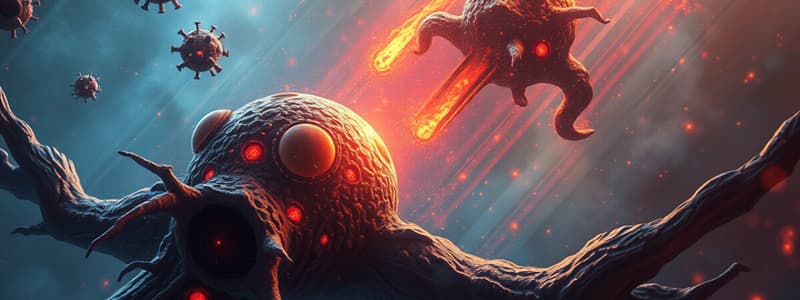Podcast
Questions and Answers
What are the cardinal signs of inflammation?
What are the cardinal signs of inflammation?
- Nausea, fatigue, redness, loss of function
- Swelling, loss of appetite, heat, fatigue
- Fever, headache, dizziness, pain
- Redness, heat, swelling, pain, loss of function (correct)
Which line of defense is characterized by the inflammatory response?
Which line of defense is characterized by the inflammatory response?
- Fourth line of defense
- Second line of defense (correct)
- First line of defense
- Third line of defense
What is true about the specificity of the inflammatory response?
What is true about the specificity of the inflammatory response?
- It occurs in the same way regardless of stimulus type. (correct)
- It takes longer to initiate compared to innate immunity.
- It is specific to the type of stimulus encountered.
- It requires memory cells for effective response.
What triggers the rapid inflammatory response?
What triggers the rapid inflammatory response?
What defines the role of the microbiome on body surfaces?
What defines the role of the microbiome on body surfaces?
Which process describes white blood cells' movement during the inflammatory response?
Which process describes white blood cells' movement during the inflammatory response?
What role do natural barriers play in immunity?
What role do natural barriers play in immunity?
What is a consequence of excessive inflammation?
What is a consequence of excessive inflammation?
What is a characteristic indication of leukocytosis?
What is a characteristic indication of leukocytosis?
Which of the following is NOT considered an acute-phase reactant?
Which of the following is NOT considered an acute-phase reactant?
Chronic inflammation may result from which of the following scenarios?
Chronic inflammation may result from which of the following scenarios?
What laboratory measure is commonly used to assess the presence of inflammation?
What laboratory measure is commonly used to assess the presence of inflammation?
Which factor is least likely to contribute to chronic inflammation?
Which factor is least likely to contribute to chronic inflammation?
What is the primary role of cytokines in the immune system?
What is the primary role of cytokines in the immune system?
What physiological response does IL-1 induce?
What physiological response does IL-1 induce?
Which cytokine is classified as an anti-inflammatory?
Which cytokine is classified as an anti-inflammatory?
What type of cells primarily produce interferons in response to viral infections?
What type of cells primarily produce interferons in response to viral infections?
What is the primary function of chemokines?
What is the primary function of chemokines?
Which statement about mast cells is accurate?
Which statement about mast cells is accurate?
What does the degranulation of mast cells involve?
What does the degranulation of mast cells involve?
Which of the following is a correct statement about interleukins?
Which of the following is a correct statement about interleukins?
What distinguishes CC-chemokines from CXC-chemokines?
What distinguishes CC-chemokines from CXC-chemokines?
What effect does the H1 receptor have when activated by histamine?
What effect does the H1 receptor have when activated by histamine?
Which characteristic is specific to chronic inflammatory responses?
Which characteristic is specific to chronic inflammatory responses?
What is a significant reason for susceptibility to bacterial infections in neonates?
What is a significant reason for susceptibility to bacterial infections in neonates?
How does aging affect innate immunity in older adults?
How does aging affect innate immunity in older adults?
Which medication is classified as an NSAID?
Which medication is classified as an NSAID?
What may impair wound healing in older adults?
What may impair wound healing in older adults?
What is the role of eosinophils in the immune response?
What is the role of eosinophils in the immune response?
Which of the following substances is released by platelets during degranulation?
Which of the following substances is released by platelets during degranulation?
What is the main function of phagocytosis?
What is the main function of phagocytosis?
What triggers the endothelium to retract during inflammation?
What triggers the endothelium to retract during inflammation?
Which of the following cells is considered an important source of IL-4?
Which of the following cells is considered an important source of IL-4?
What is the main role of mast cells in inflammation?
What is the main role of mast cells in inflammation?
Which leukocytes are primarily responsible for innate immunity and phagocytosis?
Which leukocytes are primarily responsible for innate immunity and phagocytosis?
What effect does thromboxane A2 (TXA2) have in the body?
What effect does thromboxane A2 (TXA2) have in the body?
In which stage of inflammation do neutrophils primarily function?
In which stage of inflammation do neutrophils primarily function?
What happens to monocytes during inflammation?
What happens to monocytes during inflammation?
What is the function of leukotrienes in the inflammatory response?
What is the function of leukotrienes in the inflammatory response?
Which process involves adhesion molecules and the exit of leukocytes from circulation?
Which process involves adhesion molecules and the exit of leukocytes from circulation?
What is the primary production of dendritic cells in the immune response?
What is the primary production of dendritic cells in the immune response?
Flashcards
Inflammation
Inflammation
A nonspecific response to tissue damage, can be mild or severe.
Innate Resistance
Innate Resistance
The first line of defense, involves natural barriers and immediate response.
Adaptive Immunity
Adaptive Immunity
The third line of defense, develops over time and is specific to pathogens.
Cardinal Signs of Inflammation
Cardinal Signs of Inflammation
Signup and view all the flashcards
Vascular Responses in Inflammation
Vascular Responses in Inflammation
Signup and view all the flashcards
Cellular Response in Inflammation
Cellular Response in Inflammation
Signup and view all the flashcards
Microbiome
Microbiome
Signup and view all the flashcards
Cytokines
Cytokines
Signup and view all the flashcards
Interleukins (ILs)
Interleukins (ILs)
Signup and view all the flashcards
Interferons (IFNs)
Interferons (IFNs)
Signup and view all the flashcards
Chemokines
Chemokines
Signup and view all the flashcards
Mast Cells
Mast Cells
Signup and view all the flashcards
Effects of Mast Cell Activation
Effects of Mast Cell Activation
Signup and view all the flashcards
Phagocytes
Phagocytes
Signup and view all the flashcards
Dendritic Cells
Dendritic Cells
Signup and view all the flashcards
Monocytes and Macrophages
Monocytes and Macrophages
Signup and view all the flashcards
Phagocytosis Process
Phagocytosis Process
Signup and view all the flashcards
Leukocytosis
Leukocytosis
Signup and view all the flashcards
Chronic Inflammation
Chronic Inflammation
Signup and view all the flashcards
Neonates and Immunity
Neonates and Immunity
Signup and view all the flashcards
Older Adults and Immunity
Older Adults and Immunity
Signup and view all the flashcards
Glucocorticoids
Glucocorticoids
Signup and view all the flashcards
NSAIDs
NSAIDs
Signup and view all the flashcards
Acute-phase Reactants
Acute-phase Reactants
Signup and view all the flashcards
Opsonization
Opsonization
Signup and view all the flashcards
Granuloma Formation
Granuloma Formation
Signup and view all the flashcards
H1 and H2 Receptors
H1 and H2 Receptors
Signup and view all the flashcards
Immediate Response to Injury
Immediate Response to Injury
Signup and view all the flashcards
Study Notes
Inflammation Overview
- Inflammation is a nonspecific response that occurs irrespective of the cause.
- Symptoms can vary from minor discomfort to severe pain, fever, and mobility changes.
Types of Immunity and Lines of Defense
- Innate Resistance: Natural barriers and inflammatory response (First line).
- Adaptive Immunity: Acquired immunity that develops over time (Third line).
Second Line of Defense: Inflammation
- Rapid, immediate response to tissue damage, begins within seconds.
- Non-specific response; involves cellular and chemical activities without memory.
Inflammatory Response Characteristics
- Cardinal signs include redness, heat, swelling, pain, and loss of function.
- Involves vascular responses like blood vessel dilation and increased permeability.
- Cellular response includes white blood cells adhering and migrating through vessels.
Microbiome
- Unique to each individual, shaped by environment and lifestyle.
- Composed of microorganisms that are generally non-pathogenic under normal conditions but can cause disease in immunocompromised individuals.
Cytokines
- Intercellular signaling molecules that regulate both innate and adaptive immunity.
- Can be pro-inflammatory (e.g., interleukins, TNF) or anti-inflammatory (e.g., IL-10).
Interleukins (ILs)
- Produced primarily by macrophages and lymphocytes; crucial for regulating inflammation.
- Examples:
- IL-1: pro-inflammatory, causes fever.
- IL-6: pro-inflammatory, aids healing.
- IL-10: anti-inflammatory.
Interferons (IFNs)
- Protect against viral infections and modulate inflammation.
- Released by virally infected cells to prevent further infection of healthy cells.
- Types include IFN-α, IFN-β (induce antiviral proteins) and IFN-γ (enhances macrophage activity).
Chemokines
- Attract leukocytes to inflammation sites.
- Produced by macrophages, fibroblasts, and endothelial cells, categorized into CC-chemokines and CXC-chemokines.
Mast Cells
- Contain granules and are located near blood vessels in various tissues.
- Activated by injury and chemical agents; mediate inflammation through degranulation and synthesis of inflammatory products.
Effects of Mast Cell Activation
- Histamine release causes vessel dilation and increased vascular permeability.
- Receptors:
- H1: pro-inflammatory effects, induces bronchoconstriction.
- H2: anti-inflammatory effects, stimulates gastric acid secretion.
Phagocytes
- Key immune cells include neutrophils, eosinophils, and macrophages; primarily involved in phagocytosis.
- Neutrophils are the first responders, acting within hours to clear debris and bacteria.
- Eosinophils defend against parasites and regulate the inflammatory response.
Dendritic Cells
- Link between innate and adaptive immunity; present in peripheral organs and skin.
- Facilitate maturation of T-cells and stimulate acquired immune responses.
Monocytes and Macrophages
- Monocytes mature into macrophages at the inflammation site.
- Macrophages are key initiators of inflammation and play a role in tissue repair.
Phagocytosis Process
- Involves opsonization, engulfment, phagosome formation, and destruction of targets.
Laboratory Measures of Inflammation
- Leukocytosis indicates increased white blood cell count.
- Diagnostic tests include CBC, differential count, and measures of acute-phase reactants (CRP, fibrinogen).
Chronic Inflammation
- Lasts longer than 2 weeks; can arise from unresolved acute inflammation or persistent irritants.
- Characterized by lymphocyte/macrophage infiltration and granuloma formation.
Special Considerations Across the Lifespan
- Neonates: Incomplete immune function, susceptible to infections.
- Older Adults: Impaired immune responses, increased risk for infections, effects of chronic illnesses.
Pharmacotherapy for Inflammation
- Common medications include glucocorticoids (e.g., prednisone), and NSAIDs (e.g., ibuprofen).
Signs of Inflammation
- Key signs include redness, heat, swelling, pain, and loss of function.
Studying That Suits You
Use AI to generate personalized quizzes and flashcards to suit your learning preferences.




